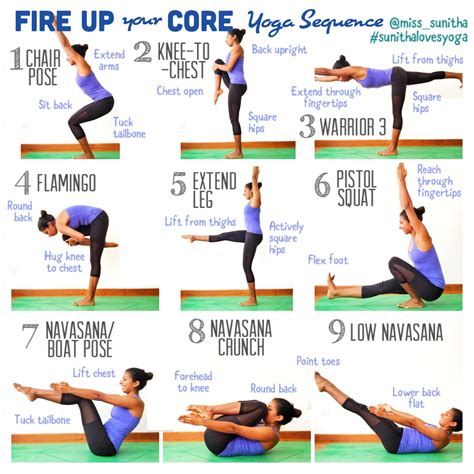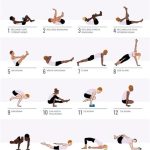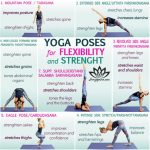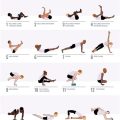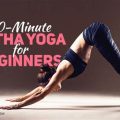Essential Core-Strengthening Yoga Poses for Beginners: A Comprehensive Guide
Yoga is widely known for its mental and physical benefits, but for beginners, its role in building core strength can be transformative. A strong core not only supports balance and posture but also protects against injuries. In this guide, we will explore core-strengthening yoga poses that are accessible to beginners and provide long-term benefits. This article aims to break down the essential poses, explain their advantages, and provide guidelines for proper execution.
Introduction
When most people think of core-strengthening exercises, they imagine sit-ups and crunches. However, yoga offers a more holistic and sustainable approach to building core strength. In addition to targeting the abdominal muscles, yoga emphasizes stability, balance, and mindful breathing, which enhance overall body control. For beginners, it is crucial to focus on form, engagement of the right muscles, and building strength progressively. This article outlines beginner-friendly poses that will not only tone your core but also provide you with a solid foundation for more advanced yoga practices.
Key Concepts
- Core Engagement: In yoga, core strength comes from more than just your abs. It involves the entire midsection, including the lower back, obliques, and pelvic floor muscles.
- Breath Control: Proper breathing is essential in yoga, especially when performing core exercises. Controlled inhalation and exhalation stabilize the body and deepen muscle engagement.
- Mind-Body Connection: Yoga requires a focus on the connection between physical movements and mental awareness. Mindful engagement of the core muscles enhances the effectiveness of each pose.
- Progressive Practice: Core strengthening in yoga is a gradual process. The focus should be on form and endurance rather than intensity or speed.
Historical Context
Yoga has been practiced for thousands of years, with its roots tracing back to ancient India. While traditional forms of yoga, such as Hatha and Ashtanga, included postures that engaged the core, the modern emphasis on core strengthening has evolved as a response to contemporary fitness trends. In the early 20th century, as yoga became popular in the West, practitioners began to highlight the benefits of yoga for core stability and overall body strength. Today, yoga for core strength is an integral part of many yoga practices, blending ancient techniques with modern understanding of anatomy and physiology.
Current State Analysis
The current fitness landscape reflects a growing interest in core workouts, particularly for beginners who may struggle with high-impact exercises. Yoga’s accessible nature makes it a popular choice for people looking to strengthen their core without straining their bodies. While core-specific fitness classes are common, many individuals are discovering that yoga offers a low-impact, full-body workout that incorporates core-strengthening in every pose.
Despite its popularity, many beginners still make the mistake of over-relying on abdominal exercises alone. This limited approach misses out on the holistic benefits of core-focused yoga poses. Core strength in yoga includes stabilizing muscles like the back, hips, and pelvic floor, which contribute to better overall body alignment and function.
Practical Applications
To practice core-strengthening yoga effectively, it’s important to start with foundational poses that emphasize proper form. Below are several essential yoga poses designed to build core strength:
- Plank Pose (Phalakasana): The plank pose is a fundamental pose for core strength. It engages the entire core, including the abdominals, shoulders, and back. Start on your hands and knees, then extend your legs back, keeping your body in a straight line.
- Boat Pose (Navasana): This pose requires balance and core engagement. Sit on the floor with your knees bent, lean back slightly, and lift your feet off the ground to form a V-shape with your body. Keep your back straight and your core engaged.
- Cobra Pose (Bhujangasana): While primarily a backbend, Cobra strengthens the lower back, which is a key component of the core. Lie on your stomach and gently lift your chest while keeping your pelvis on the floor.
- Bridge Pose (Setu Bandhasana): This pose strengthens the lower back and glutes, which are critical for overall core stability. Lie on your back, bend your knees, and lift your hips off the ground while pressing your feet into the floor.
Case Studies
To illustrate the effectiveness of core-strengthening yoga, let’s look at two case studies:
- Case Study 1: Susan’s Recovery from Lower Back Pain: Susan, a 45-year-old office worker, had chronic lower back pain due to poor posture and weak core muscles. After three months of practicing core-focused yoga, including poses like Plank and Bridge, she reported significant pain reduction and improved posture.
- Case Study 2: John’s Improved Athletic Performance: John, a 28-year-old amateur runner, struggled with balance and stability during his runs. Incorporating Boat Pose and Cobra Pose into his yoga routine helped him improve his core strength, leading to better endurance and fewer injuries.
Stakeholder Analysis
Core-strengthening yoga benefits a wide range of stakeholders, including:
- Beginners: People new to yoga can gradually build core strength through accessible poses, improving their overall fitness.
- Athletes: For athletes, core strength is essential for performance, injury prevention, and stability.
- Health Professionals: Physical therapists and fitness trainers can use core yoga poses to support clients recovering from injury or surgery.
- Yoga Instructors: Teachers can help students focus on proper alignment and core engagement, offering modifications as needed.
Implementation Guidelines
For beginners, it’s essential to practice core-strengthening yoga with attention to alignment, breath, and gradual progression. Here are some guidelines:
- Start Slow: Focus on a few key poses and gradually build your strength and endurance.
- Listen to Your Body: Never force a pose. If you feel strain or discomfort, ease back or use modifications.
- Use Props: Blocks, straps, and blankets can help beginners maintain proper form and alignment.
- Consistency is Key: Practicing regularly, even for a few minutes a day, will yield better results than sporadic sessions.
Ethical Considerations
Practicing core-strengthening yoga, like any exercise regimen, should be done responsibly to avoid injuries. Instructors must ensure that they offer modifications and monitor students for proper form. Overexertion can lead to unnecessary strain, particularly in the lower back. Ethical teaching practices also require instructors to respect each student’s limitations and encourage safe, progressive improvement.
Limitations and Future Research
While yoga is highly effective for building core strength, it has its limitations. For example, those with severe spinal issues may require specialized modifications or alternative forms of core strengthening. More research is needed to fully understand the long-term effects of yoga-based core training on individuals with pre-existing conditions like scoliosis or herniated discs. Additionally, future studies could explore the intersection of yoga and other fitness modalities to develop more integrative approaches for core strengthening.
Expert Commentary
Experts agree that core strengthening is an essential component of overall health, and yoga provides a holistic approach that can benefit beginners and advanced practitioners alike. According to leading yoga instructors, the key to successful core strengthening is consistency, mindful engagement of the muscles, and proper breathing techniques. While traditional abdominal exercises often isolate muscles, yoga offers a more balanced and comprehensive workout that enhances both strength and flexibility.
Incorporating these core-strengthening yoga poses into your practice can help build not only a stronger body but also a more resilient mind. With dedication, even beginners can achieve significant improvements in core strength, balance, and overall fitness.
